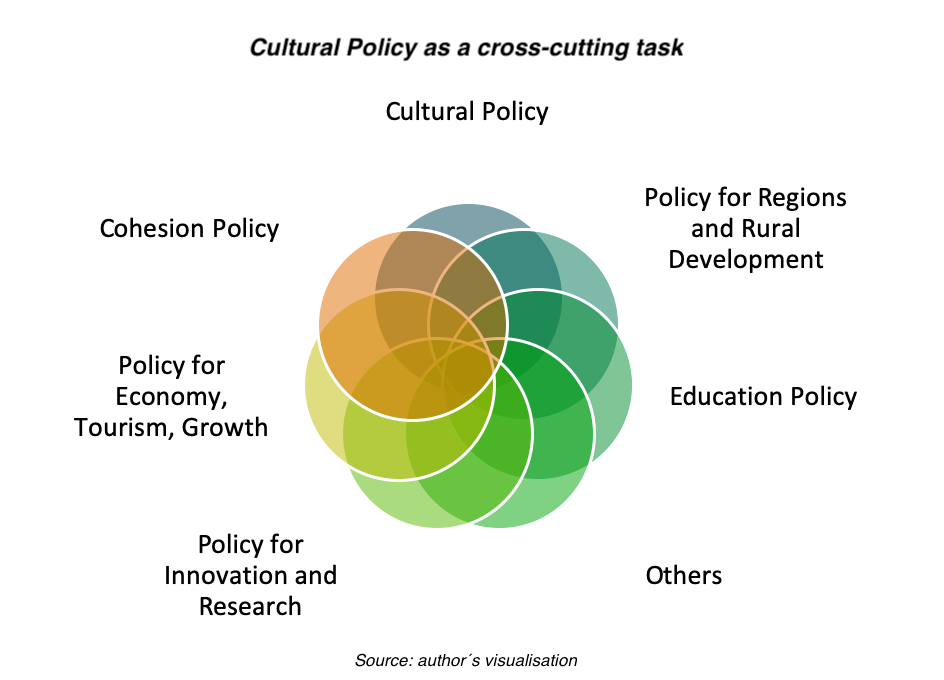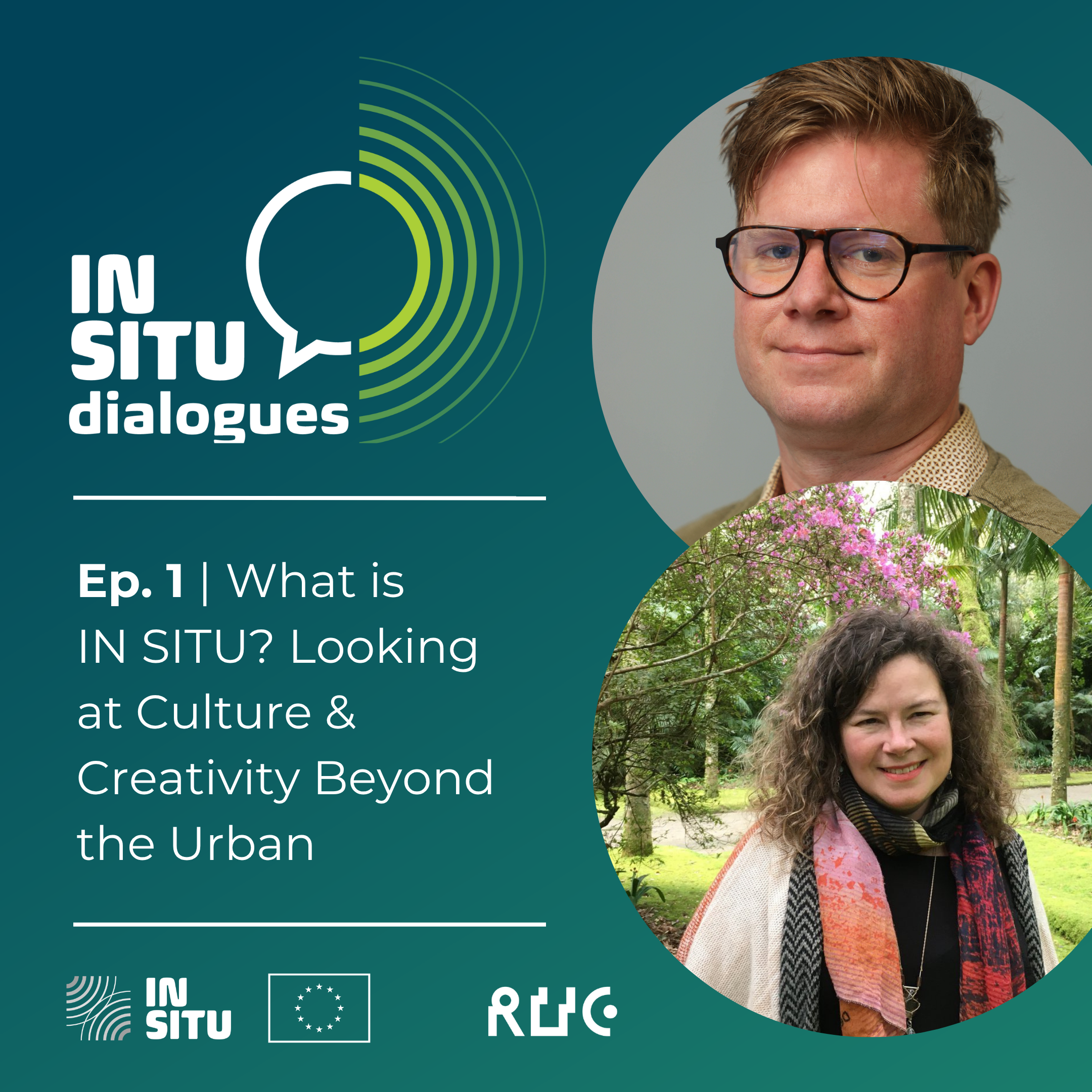Based on a mixed-methods design of desktop research, document analysis, interviews, focus groups, and site visits, the report State of Cultural Policies for CCIs in Non-urban Areas, developed within the IN SITU project, presents and discusses findings from an analysis of the diverse field of policy concepts, contexts, organisations and (decision-making) structures relating to culture in the EU. The report was developed by the IN SITU research team of the University of Hildesheim (SUH).
Beyond the review of EU cultural policy, the national and territorial levels were analysed, focusing on the six IN SITU Lab regions: Azores, Portugal; Western coastal region, Ireland; Western region, Iceland; Rauma and Eurajoki municipalities, Finland; Valmiera County, Latvia; Šibenik-Knin County, Croatia. For each of the locations, the review involves the national level of cultural policy related to CCIs and the cultural and creative ecosystems of non-urban areas as well as territorial aspects and specificities of the regional and local levels, wherever it was relevant. In addition, the report examines the strategies and planning, means of implementation and programmes in multi-level policy frameworks.
In this review, although the focus was on governmental structures and arrangements, cultural policy is seen not only as a task of governmental entities, but inclusive also of networks and other activities of cultural and creative actors actively working though social innovations to contribute to social cohesion and shape regional transformation.
Organised in two parts, the report first provides, and reflects on, a comprehensive overview of existing cultural policy structures at the European level. This initial analysis aims to present the complexity of the levels and programmes and to clarify the various reference systems. This section also highlights how decisions are implemented in the various programmes. The research finds that cultural policy on the EU level is, until today, generally based on a more urban-centred and economic view on CCIs, culture and creativity. There are very few hints that the stakeholders, structures, potentials, challenges and needs of CCIs embedded in cultural and creative ecosystems in non-urban areas are on the political agenda – and if they are, the focus is mainly on cultural heritage and the potential of non-urban or rural development through cultural tourism. These observations complement the research findings presented in the previous IN SITU report, State of Policies and S3s on Innovation and CCIs in Non-urban Areas.
Secondly, the report presents the findings from examining the cultural policy structures and approaches found in the six IN SITU Lab regions. Beyond a striking variety of cultural policy concepts, structures, strategies, programmes and different administrational, political, socio-economic and place-based backgrounds, several similarities were identified:
- The role and significance of non-urban CCIs related to innovation is mainly unseen;
- Culture and creativity in non-urban areas are widely reduced to the function of “serving” for education, heritage and identity-building;
- A strongly urban-oriented view of those who decide and develop priorities, strategies and programmes;
- A lack of specific strategies and programmes taking into account the various and different needs and potentials of CCIs in diverse non-urban, rural and remote areas;
- A need for data, research and discourse on this fluid and overlapping policy field with unclear edges;
- Much relevant information, data and knowledge of local and regional actors and place-based issues remain invisible to research, international discourses and at the EU level. This is due, in particular, to oral communication patterns, languages not spoken internationally, remoteness from urban discourses, and place-based issues that are sometimes linked to place-based narratives and dynamics; and
- Desktop research and quantitative methods are limited because of a lack of data and accessible reports on these non-urban areas. Qualitative and ethnographic or community-engaged research methods are still rarely used in a cultural policy research context.

“Cultural Policy? Oh no, we don’t have any cultural policy here!” – this was the typical answer to the researchers’ question on local and regional cultural policy in the IN SITU Lab areas, which pointed to a wide-spread phenomena in Europe’s non-urban territories. Even if a more detailed look on place-based cultural policy revealed some contradictions to this polemic expression, it can be generally stated that, as a result of this investigation into non-urban territories of several EU member states, national cultural policy lacks a focus on non-urban issues.
On the other hand, it also became clear from the IN SITU Labs in the Azores (Portugal), Western coastal periphery region (Ireland) and West region (Iceland), for example, that as soon as the topic was discussed, regional cultural policy networks and modes of action crystallised and were often only ‘recognised’ in joint discussions and workshops. Overall, a very diverse picture of different actors and responsibilities that characterise the respective regional cultural policies have emerged.
Another general finding resulted from a close examination of local policies. Place-based needs and the local potentials of CCI stakeholders stay relatively often unseen. They lack adequate enabling structures that foster their innovation capacity and involvement in the shaping of local and regional transformation processes to enhance social cohesion and contribute to the sustainability, vitality and resilience of local and regional communities. Political and administrative entities and granting systems, if existing, rarely consider CCI stakeholders as partners in alliances for common goals but more often see them as funding recipients or providers of cultural services in the areas of tourism, heritage protection, education and image-building.
Nevertheless, it is remarkable that bottom-up activities for social innovation are often tested and organised by CCI actors and their informal networks. This type of active and civil policymaking for local societies reveals good practices of how to manage ongoing transformation processes. Those activities are also valuable contributions to regional development. Whenever they are supported by flexible measures that meet the individual needs of local and regional CCIs, these movements and actions of citizenship seem to promote vitality and resilience.
The information, questions and results gathered, and the structures and frameworks presented in this report, both at the European and IN SITU Lab levels, will inform further cultural policy analysis and discussion to develop cultural policy recommendations for non-urban areas in Europe. These will be discussed with multi-level stakeholders in the course of the IN SITU project and published in the outcome report, Handbook on policy, strategies and planning for CCIs in non-urban areas, in June 2026.
For further information:
Nancy Duxbury – IN SITU Project Coordinator
Centre for Social Studies (CES) at the University of Coimbra, Portugal
Email: in-situ@ces.uc.pt
Tel: +351 239 855 570
Web: https://insituculture.eu
The “IN SITU: Place-based innovation of cultural and creative industries in non-urban areas” project combines research and experimental actions to advance the innovation-related practices, capacities, and potential of cultural and creative industries (CCIs) based in non-urban areas of the EU. The project is funded by the European Commission under the Horizon Europe Program (project no.101061747). It began on July 1, 2022, and will run for four years. The IN SITU project consortium comprises 13 Full Partners from 12 countries, consisting of 11 research institutions, a European-wide cultural network, and a national cultural foundation.




